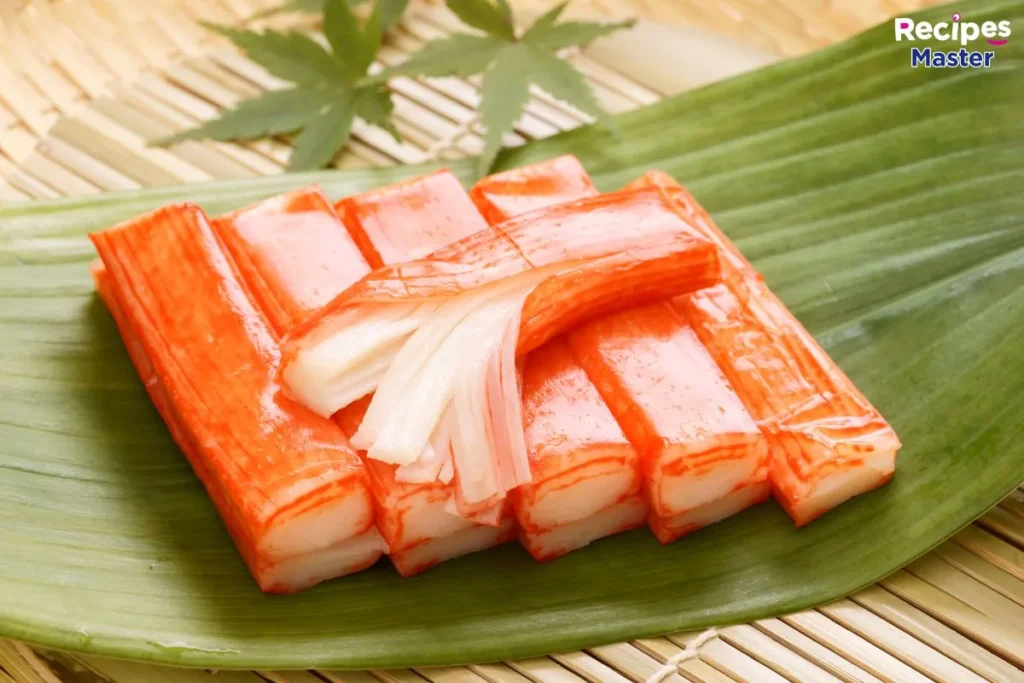
Discovering the Taste of Kani Kama
Ever wondered about the taste of kani kama while browsing your local grocery’s seafood section? Surely, you’re not alone. Many share this culinary curiosity, which drives them to discover new flavors. Significantly, kani kama, or imitation crab meat, has intrigued global taste buds and become a staple in various dishes.
To begin with, culinary experts craft kani kama to mimic the delicate taste and texture of real crab meat. They blend finely pulverized white fish, usually pollock, with starch, egg whites, and crab flavoring. This meticulous process creates something both familiar and novel. Hence, the result is a versatile, delicious ingredient.
Imagine the sweet, slightly briny flavor of crab with a subtle oceanic hint. Moreover, kani kama offers a tender yet firm texture, satisfying with each chew. Indeed, it’s a nod to food science’s ingenuity and the sea’s flavors.
Furthermore, kani kama excels in many dishes, from California rolls to seafood salads. It blends seamlessly, enhancing dishes without overpowering them. Consequently, both chefs and home cooks value its versatility.
In conclusion, let’s dive deeper into the world of kani kama. We’ll explore its origins, culinary uses, and what makes it fascinating for food enthusiasts. Whether you’re a seasoned chef or a curious foodie, kani kama’s story promises to engage your taste buds and imagination.
Understanding Kani Kama
What is Kani Kama?
Kani kama, often celebrated for its role in sushi rolls and seafood salads, stands out as a culinary chameleon. Essentially, it’s a type of surimi, or processed seafood, crafted to mimic the taste and texture of crab meat. The journey of kani kama begins with white fish, typically pollock, which undergoes a transformation. Through grinding, seasoning, and shaping, this fish turns into the beloved seafood substitute known worldwide.
The Ingredients Behind Kani Kama
Delving deeper, the magic of kani kama lies in its simple yet effective ingredients. Pollock provides the base, offering a neutral canvas for flavors. Manufacturers then add starch to bind the mixture, ensuring a firm texture reminiscent of crab meat. Egg whites enhance this texture, contributing to the kani kama’s signature bite. Flavorings, including crab extract, infuse the surimi with its characteristic seafood taste. Together, these ingredients create a product that’s both versatile in the kitchen and accessible to seafood lovers everywhere.
Health and Nutritional Benefits
Beyond its culinary uses, kani kama offers several health and nutritional benefits. It’s a low-calorie option for those mindful of their intake, yet rich in high-quality protein. Additionally, kani kama contains omega-3 fatty acids, contributing to heart health and cognitive function. While it’s lower in cholesterol than traditional crab meat, it’s important to note the presence of additives and sodium. Thus, enjoying kani kama as part of a balanced diet allows one to reap its benefits without overindulgence.
Culinary Experience
The Flavor Profile of Kani Kama
Kani kama offers a unique taste experience that both intrigues and delights. Its flavor, mildly sweet with a subtle brininess, closely resembles that of crab meat, making it a favorite among seafood enthusiasts. The texture, however, is where kani kama truly shines. It achieves a balance between tender and firm, providing a satisfying chew that enhances any dish it accompanies. This versatility allows it to star in a variety of culinary creations, from simple salads to elaborate sushi rolls.
Kani Kama in Culinary Creations
The culinary applications of kani kama are vast and varied. In sushi, it’s a key ingredient in California rolls, where its flavor complements the creamy avocado and crisp cucumber. It also makes an excellent addition to seafood salads, mixed with mayo and fresh herbs for a light, flavorful dish. Beyond these classics, creative cooks have incorporated kani kama into pastas, casseroles, and even wraps, showcasing its adaptability in both hot and cold recipes.
Comparison with Real Crab Meat
While kani kama does an admirable job of mimicking crab meat’s flavor and texture, there are noticeable differences. Real crab meat possesses a depth of flavor and a tenderness that kani kama can approximate but not fully replicate. However, kani kama’s convenience, affordability, and longer shelf life make it an appealing alternative for many dishes. It allows those on a budget or without access to fresh seafood to enjoy the essence of crab in their cooking.
Consumer Insights
What Do People Say?
Feedback on kani kama varies, with many praising its versatility and flavor as a seafood substitute. Home cooks appreciate its ease of use and ability to elevate dishes with a hint of the sea. However, purists may note the difference in taste and texture from real crab meat, emphasizing that while kani kama is a commendable alternative, it doesn’t replace the authentic experience.
Tips for First-Time Tasters
For those trying kani kama for the first time, here are a few tips: start with a simple dish, like a salad or sushi roll, to appreciate its flavor. Be mindful of the quality, as not all kani kama is created equal. And most importantly, keep an open mind. Kani kama offers a unique culinary experience, one that’s worth exploring for its contributions to accessible, delicious seafood dishes.
Frequently Asked Questions
What dishes can you make with kani kama?
Kani kama’s versatility shines in a variety of dishes. Beyond the well-loved California rolls and seafood salads, it’s a fantastic addition to omelets, spring rolls, and even as a topping for pizzas. Its ability to blend with different ingredients makes it a go-to for innovative cooks looking to add a seafood twist to their meals.
How do you differentiate kani kama from real crab meat?
The key differences lie in taste, texture, and appearance. Kani kama has a uniform texture and a mildly sweet taste, while real crab meat offers a more complex flavor profile and a flakier texture. Visually, kani kama is often more brightly colored, usually orange or red, mimicking the appearance of cooked crab.
Is kani kama suitable for people with seafood allergies?
Kani kama is made from fish, typically pollock, so individuals with fish allergies should avoid it. However, for those allergic to shellfish but not to other types of seafood, kani kama can be a safe alternative to enjoy the taste of crab without the allergenic risks associated with shellfish.
What Does Kani Kama Taste Like?
Kani kama, also known as imitation crab, is a popular ingredient in sushi rolls, salads, and seafood dishes. But what exactly does it taste like, and why is it so widely used in culinary arts? In this article, we’ll dive into the taste profile of kani kama, how it’s made, and its role in various cuisines.
The Taste Profile of Kani Kama
Kani kama is known for its mild, sweet flavor that closely mimics the taste of real crab meat. It’s made from white fish, such as pollock, that is minced and processed with starch, egg whites, and crab flavoring to resemble the taste and texture of crab meat. The result is a convenient, cost-effective alternative to real crab that can be used in a variety of dishes.
Culinary Uses of Kani Kama
Kani kama is versatile and can be used in many different culinary applications. From delicious and nutritious air fryer mushroom recipes to being a staple in sushi rolls, kani kama adds a touch of seafood flavor without the expense of real crab. It’s also commonly used in seafood salads, crab cakes, and as a filling in wontons or dumplings.
Related Articles
To learn more about how to incorporate kani kama into your cooking, check out these related articles on RecipesMaster.net:
- Top Imitation Crab Recipes: Delicious & Easy Seafood Dishes
- What is the Best Way to Eat Imitation Crab Meat?
- Can You Cook Imitation Crab?
- Eating Imitation Crab Raw: Guide
- For a deeper dive into the topic of kani kama, visit the comprehensive guide at Kani Kama.
Conclusion
Final Thoughts on the Taste of Kani Kama
Embarking on the journey to explore what does kani kama taste like? opens up a world of culinary possibilities. This imitation crab meat, while not a perfect substitute for the real deal, stands on its own as a delightful ingredient that brings the essence of the sea to a variety of dishes. Its convenience, affordability, and nutritional profile make it a worthy addition to the pantry of any home cook looking to experiment with seafood flavors.
Whether you’re crafting a simple weeknight dinner or a sophisticated sushi platter, kani kama offers a blend of taste and texture that can elevate your cooking. As we’ve seen, its applications are only limited by one’s creativity, and its ability to mimic crab meat makes it an accessible option for seafood lovers everywhere.
In conclusion, kani kama may not replace the depth and richness of real crab meat for every palate, but it certainly earns its place in the culinary world. By providing a bridge to seafood flavors for those on a budget, with dietary restrictions, or simply seeking convenience, kani kama enriches our dining experiences in its own unique way.
As we’ve explored the nuances of kani kama’s taste, uses, and consumer perceptions, it’s clear that this imitation crab meat is more than just a substitute; it’s a testament to the creativity and adaptability of modern cuisine. So, the next time you encounter kani kama in your local grocery store, consider the myriad ways it could inspire your next culinary adventure.
